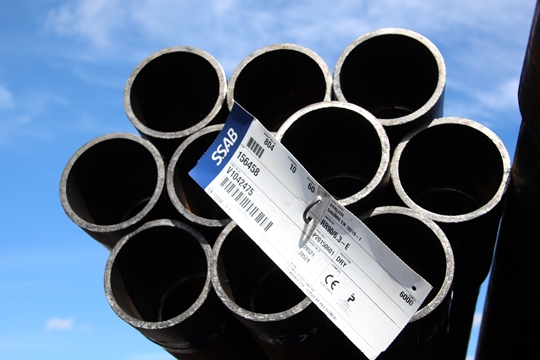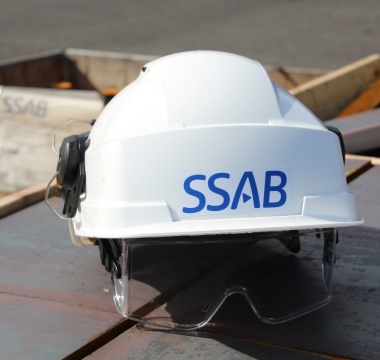Environmental responsibility and sustainability
SSAB develops new products and services in order to improve our customers’ performance in sustainability and overall efficiency.
Download certificatesSSAB develops new products and services in order to improve our customers’ performance in sustainability and overall efficiency.
Download certificatesLife cycle assessments data for SSAB’s products is available in the form of Environmental product declarations (EPDs). Manufacturing chain from raw material to finished product is carefully managed.
SSAB has introduced CE marking for infrastructure products. Declarations of Performance (DoP) indicate the technical characteristics of CE marked products.
Manufacturing chain from raw material to finished product is carefully managed and controlled.
SSAB’s own steel manufacturing in the Nordics is followed by own tube manufacturing for piles and profiling for sections. Tube manufacturing is followed by value adding and outfitting of piles. This guarantees excellent production control and high quality product.
SSAB is a forerunner in high strength steel grades. New solutions enable to reduce emissions and carbon footprint.
SSAB was the first steel pile manufacturer to introduce CE marking for piling products in May 2013. SSAB's safety barriers are also CE marked.
CE marking covers the entire pile structure, manifests the requirements and conformity of the mechanical splices. It ensures that the product has been manufactured specifically for piling. Safety barriers have been tested in crash tests complying with EN 1317.
Declaration of Performance (DoP) indicates the technical characteristics of CE marked products. Each construction product covered by a European harmonized standard or for which a European Technical Assessment has been issued needs this Declaration and has to be CE marked.
We at SSAB are answering to the increased demand of life cycle assessments in the construction industry.
SSAB provides environmental information in a form of environmental product declaration, which is prepared according to ISO EN 15804 and EN ISO 14025 and verified by a 3rd party. SSAB’s tubular product’s Environmental product declaration (EPD) includes Piles, structural hollow sections, precision tubes, line pipes and steel sections. All the SSAB’s Life cycle assessment (LCA) data is based on the actual manufacturing processes in Raahe Steel mill and tube mills.
SSAB’s steel piles are included in the Swedish Byggvarubedömningen and Sundahus directories. In Swedish Byggvarubedömningen classification SSAB’s steel piles have been rated with the highest grade, ”Recommended”. In Swedish SundaHus SSAB’s steel piles have been rated with a value B (A-D), that is a product that does not cause risks on human health or the environment.
SSAB's piles, structural hollow sections, precision tubes, line pipes and steel sections are included in the EPD-Norway. In the registry the environmental information is provided in a standardized and objective way. SSAB's declaration is verified by an approved independent verifier and further approved by the Norwegian EPD Foundation. The declaration is created according to product specific Product group rules (PCR). In addition to the European standard EN 15804 requirements, the PCR requires that transport from production place to user (module A4) is included and the national electricity mix is used in the EPD. Further information can be found in the EPD.

We at SSAB offer relevant product data and instructions on how our solutions can help our customers achieve high ratings. SSAB has long accumulated expertise in environmental certification systems for buildings and the aim is to support customers to apply for certification. SSAB has knowledge and ability to support customers in environmental certification systems like LEED.
The proportion of recycled material in a product is calculated based on overall material costs, the LEED credit requirements being:
Estimated recycled content for steel products such as piles, beams, columns, trusses, load bearing sheets and steel claddings is 25 percent.
The proportion of regionally produced material in a product is calculated based on overall material costs, the LEED credit requirements being:
Credits are awarded when the total travel distance of the products raw materials is less than 800 km.
Use on-site renewable energy systems to offset building energy costs.Calculate project performance by expressing the energy produced by the renewable systems as a percentage of the building's annual energy cost and use the table below to determine the number of points achieved.
Use the building annual energy cost calculated in EA Credit 1: Optimize Energy Performance or the U.S. Department of Energy's Commercial Buildings Energy Consumption Survey database to determine the estimated electricity use. The minimum renewable energy percentage for each point threshold is as follows:
Steel in construction has many benefits which link to Green Building – structures are light, construction times are short and materials are extremely recyclable.
We at SSAB offer relevant product data and instructions on how our solutions can help our customers achieve high ratings. SSAB has long accumulated expertise in environmental certification systems for buildings and the aim is to support customers to apply for certification. SSAB has knowledge and ability to support customers in environmental certification systems like BREEAM.
MAT 03 Responsible sourcing of materials — 1 to 3 credits
The raw material used in the production is hot-rolled steel coils manufactured at SSAB‘s Raahe Steel Works in Finland and manufactured into piling products in various SSAB‘s facilities. All production processes are ISO 14001 certified.
